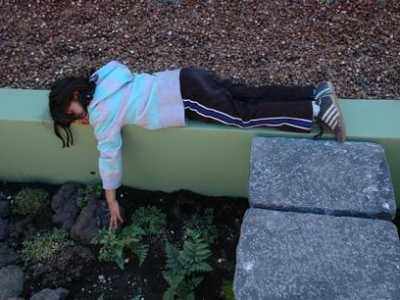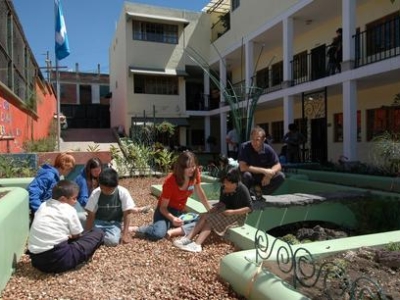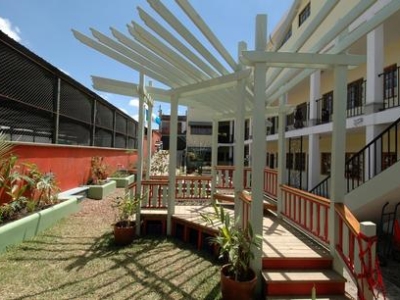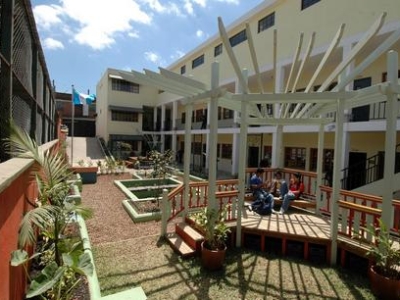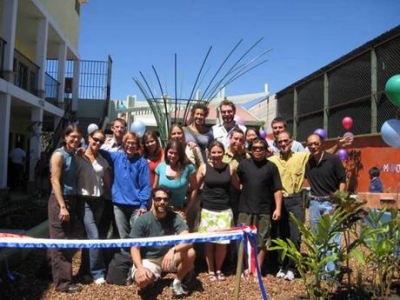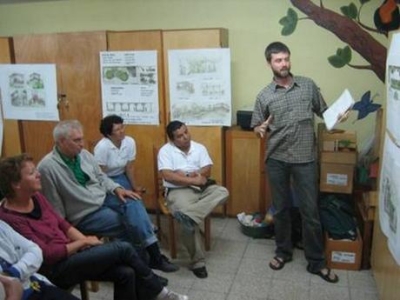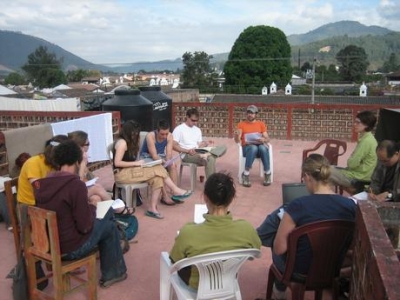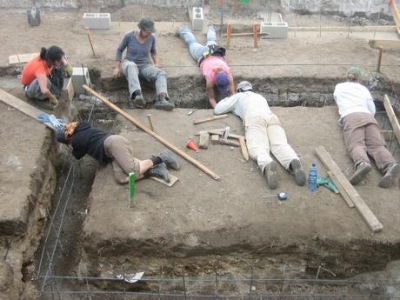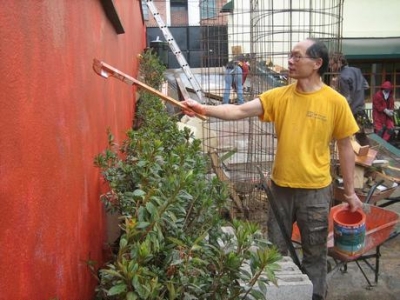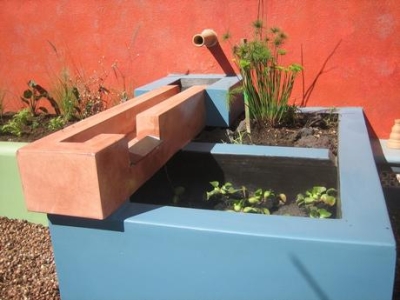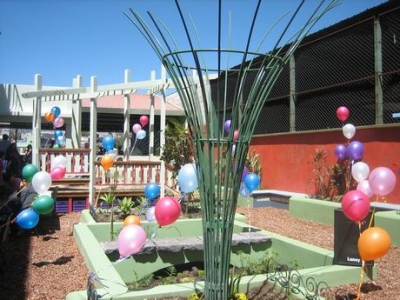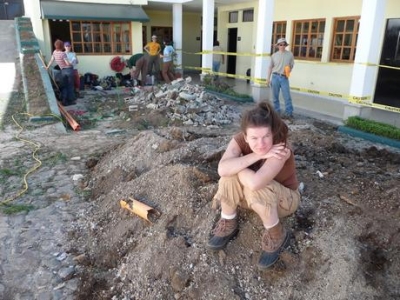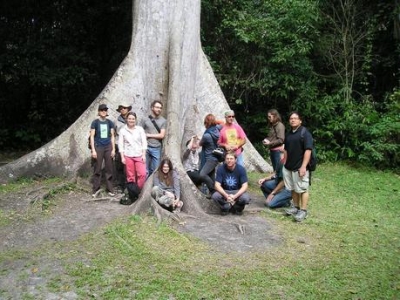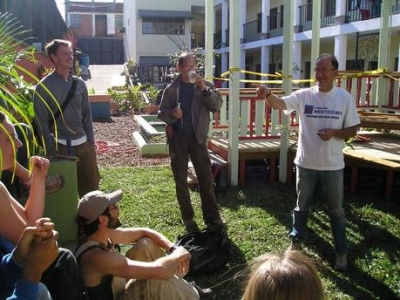The Winter Design/Build 2008 Program offers students a unique service learning opportunity to study in one of the world’s most interesting countries, Guatemala. Rich in Mayan history and culture, Guatemala is an ecologically important with great swaths of forested land still intact and populations of endangered species threatened. This program is designed to meet two primary goals. First it offers students the opportunity to explore, observe and study in this unique country and gain insight into a unique culture and appreciate its vernacular environmental design. Second, the opportunity to work with a unique client and design and build an invaluable open space that will nurture and stimulate the children, their families and the community of garbage pickers.
Students will work with the client, Safe Passage (see description below), and the faculty to design and build an “outdoor classroom”. Students will learn the skills of small culturally appropriate site design and construction detailing through this intensive project. The process is formed around the collaborative model of inclusive design. Once the design is completed, each student will take on individual responsibilities for various aspects of the project. The rapid pace of both the design and construction will demand a deep level of commitment and responsibility. In the design phase, students will be taught graphics, site design, and construction documentation and learn what a “therapeutic garden” is and how it might function. In the building phase, students will be taught the principles and methodologies of construction, how to use tools, calculate materials and cost estimating. The students will also learn through the children and volunteers of Safe Passage and gain insight into how people survive in radically different cultures and in great depravation.
The park site is located in Zona #3, one of the poorest neighborhoods in the Guatemala City. The site, a former garbage dump has been partially cleared and a wall was recently erected around its perimeter to prevent land invasions and a pre-school is currently being erected on the park site. The park is surrounded on two sides by the squatter community, on another by the garbage dump; the largest in the city, where the families scavenge.
Goals of the Project
- The creation of a park (Children’s Peace Park) to be used by the children of Safe Passage to reduce their daily stresses, and accommodate a range of activities including vocational training, recreation and ecological awareness. The park will also serve as a therapeutic environment and safe refuge within the often violent and dangerous squatter community.
- In a working session with Safe Passage children and staff and the U of WA’s students and faculty develop a program that meets the needs of the existing and planned future programs for Safe Passage.
- Develop construction documents that articulate the design intent and can be implemented within the construction budget.
- Implement the third phase of the park and work with the Safe Passage’s staff and administrators to complete a maintenance plan.
Outcome of the Project
- The creation of a therapeutic learning environment that accommodates the therapeutic, academic, vocational, and recreational goals of the Safe Passage curriculum.
- The creation of a replicable community service model.
- Conduct a continuing evaluation based on follow up interviews over the next two years, to monitor and evaluate the park and document its use.
Participants
Landscape Architecture Design Build Program
The University of Washington Landscape Architecture Design Build Program has been asked by Camino Segura/Safe Passage a non-governmental agency based in Antigua Guatemala to design and build a number of components in a Park designed for children and to be used as a part of their educational outreach and support program. The children are from the families of the garbage pickers who were pulled out of school by their families to harvest garbage for resale in an effort to increase the family income. Safe Passage is supporting the children in their effort to gain an education and break the cycle of dropouts/garbage picking. The park will be integrated into the programs curriculum and is intended to offer therapeutic, educational, vocational and recreation support and opportunities.
Students will work with the client, Safe Passage (staff, administrators and children (see description below), and the faculty to design and build an “interactive landscape. Students will learn the skills of small site design and construction detailing, management, community participation.
Faculty
The Landscape Architecture Design Build Program in Guatemala will be taught by Daniel Winterbottom, Associate Professor of Landscape Architecture, Urban Design, and Adjunct Associate Professor of Architecture. The Design/Build Program was initiated by Professor Winterbottom in 1995 and over the past decade has completed a diverse range of projects. The projects include a public wash facility for a rural community in central Mexico; several projects in Seattle including an intergenerational play and recreational area, an outdoor classroom and environmental learning facility, a community adopt-a-park in the Cascade neighborhood, two formerly paved spaces on the UW’s west campus that were transformed into green space for staff and students; and a series of gardens for a foster home for children with AIDS in New York City.
Camino Seguro/Safe Passage
Located in both Guatemala City and Antigua, Guatemala, Safe Passage was founded in 1999 in an effort to help the poorest of Guatemala’s children break out of poverty in a dignified and permanent way through education. Working with children living near the garbage dump, Safe Passage has turned the dream of education into a reality for more than 500 children.
Children are the hidden victims of poverty. As innocent victims, born into poverty, they are forced by their parents to drop out of school and work aside their families to pick through the garbage and sell what they can, to eke out their minimal survival, amidst the domestic violence, alcoholism, and drug and sexual abuse that plagues their neighborhoods.
Safe Passage offers a wide range of services for the children of these families. By providing ongoing school support in the form of school enrollment, supplies, books and uniforms, Safe Passage supports children in twelve area public schools. Each child can earn assistance with clothing, shoes and other needed items, by regularly attending school and the daily reinforcement program. Safe Passage also provides home and school visits to provide each child with additional support and a powerful awareness that someone cares deeply about them and their future.
The reinforcement program assists children with their homework and provides creative, meaningful hands on activities to reinforce their skills. Safe Passage depends on local and foreign volunteers to provide the children with individual attention they so desperately need. Volunteers are instrumental in the planning and administration of these activities. The park will play a significant role in the activities Safe Passage administers. It is intended to be a place of learning, recreation, exploration and healing. As a safe place, where children can express themselves as children, they will also learn about their local culture and ecology. The park will be a unique refuge in a neighborhood torn between poverty, violence and despair.
This collaborative relationship between the Safe Passage and the University of Washington offers a wonderful opportunity to combine teaching, research and to develop across discipline interaction between the Safe Passage personnel and the Department of Landscape Architecture. The design/build program represents an innovative model for teaching, intellectual exchange and service learning, and when realized, will provide a valuable community asset for the people of Zona #3 Guatemala City.
